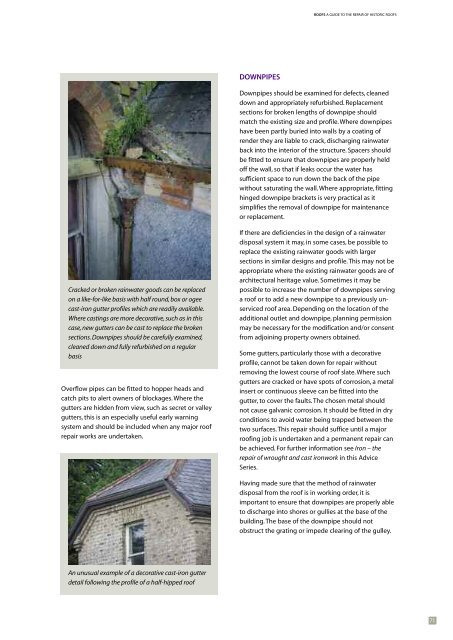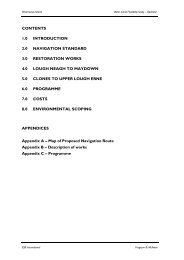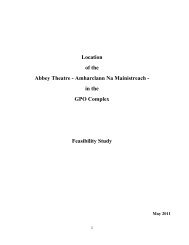A Guide to the Repair of Historic Roofs - Dublin City Council
A Guide to the Repair of Historic Roofs - Dublin City Council
A Guide to the Repair of Historic Roofs - Dublin City Council
Create successful ePaper yourself
Turn your PDF publications into a flip-book with our unique Google optimized e-Paper software.
ROOFS A GUIDE TO THE REPAIR OF HISTORIC ROOFSDOWNPIPESDownpipes should be examined for defects, cleaneddown and appropriately refurbished. Replacementsections for broken lengths <strong>of</strong> downpipe shouldmatch <strong>the</strong> existing size and pr<strong>of</strong>ile. Where downpipeshave been partly buried in<strong>to</strong> walls by a coating <strong>of</strong>render <strong>the</strong>y are liable <strong>to</strong> crack, discharging rainwaterback in<strong>to</strong> <strong>the</strong> interior <strong>of</strong> <strong>the</strong> structure. Spacers shouldbe fitted <strong>to</strong> ensure that downpipes are properly held<strong>of</strong>f <strong>the</strong> wall, so that if leaks occur <strong>the</strong> water hassufficient space <strong>to</strong> run down <strong>the</strong> back <strong>of</strong> <strong>the</strong> pipewithout saturating <strong>the</strong> wall. Where appropriate, fittinghinged downpipe brackets is very practical as itsimplifies <strong>the</strong> removal <strong>of</strong> downpipe for maintenanceor replacement.Cracked or broken rainwater goods can be replacedon a like-for-like basis with half round, box or ogeecast-iron gutter pr<strong>of</strong>iles which are readily available.Where castings are more decorative, such as in thiscase, new gutters can be cast <strong>to</strong> replace <strong>the</strong> brokensections. Downpipes should be carefully examined,cleaned down and fully refurbished on a regularbasisOverflow pipes can be fitted <strong>to</strong> hopper heads andcatch pits <strong>to</strong> alert owners <strong>of</strong> blockages. Where <strong>the</strong>gutters are hidden from view, such as secret or valleygutters, this is an especially useful early warningsystem and should be included when any major ro<strong>of</strong>repair works are undertaken.If <strong>the</strong>re are deficiencies in <strong>the</strong> design <strong>of</strong> a rainwaterdisposal system it may, in some cases, be possible <strong>to</strong>replace <strong>the</strong> existing rainwater goods with largersections in similar designs and pr<strong>of</strong>ile. This may not beappropriate where <strong>the</strong> existing rainwater goods are <strong>of</strong>architectural heritage value. Sometimes it may bepossible <strong>to</strong> increase <strong>the</strong> number <strong>of</strong> downpipes servinga ro<strong>of</strong> or <strong>to</strong> add a new downpipe <strong>to</strong> a previously unservicedro<strong>of</strong> area. Depending on <strong>the</strong> location <strong>of</strong> <strong>the</strong>additional outlet and downpipe, planning permissionmay be necessary for <strong>the</strong> modification and/or consentfrom adjoining property owners obtained.Some gutters, particularly those with a decorativepr<strong>of</strong>ile, cannot be taken down for repair withoutremoving <strong>the</strong> lowest course <strong>of</strong> ro<strong>of</strong> slate. Where suchgutters are cracked or have spots <strong>of</strong> corrosion, a metalinsert or continuous sleeve can be fitted in<strong>to</strong> <strong>the</strong>gutter, <strong>to</strong> cover <strong>the</strong> faults. The chosen metal shouldnot cause galvanic corrosion. It should be fitted in dryconditions <strong>to</strong> avoid water being trapped between <strong>the</strong>two surfaces. This repair should suffice until a majorro<strong>of</strong>ing job is undertaken and a permanent repair canbe achieved. For fur<strong>the</strong>r information see Iron – <strong>the</strong>repair <strong>of</strong> wrought and cast ironwork in this AdviceSeries.Having made sure that <strong>the</strong> method <strong>of</strong> rainwaterdisposal from <strong>the</strong> ro<strong>of</strong> is in working order, it isimportant <strong>to</strong> ensure that downpipes are properly able<strong>to</strong> discharge in<strong>to</strong> shores or gullies at <strong>the</strong> base <strong>of</strong> <strong>the</strong>building. The base <strong>of</strong> <strong>the</strong> downpipe should no<strong>to</strong>bstruct <strong>the</strong> grating or impede clearing <strong>of</strong> <strong>the</strong> gulley.An unusual example <strong>of</strong> a decorative cast-iron gutterdetail following <strong>the</strong> pr<strong>of</strong>ile <strong>of</strong> a half-hipped ro<strong>of</strong>71
















